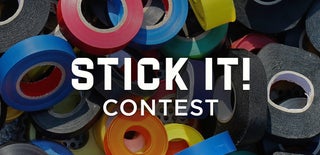Introduction: How to Make Guitar Picks From Reclaimed Metals
Hi there,
while listening to one of my favorite podcasts, the reclaimed audio podcast, I found out that one of the hosts, William Lutes, had started to make cigar box guitars for sale. Since I felt inspired by the podcast I wanted to give something back as a little motivation for Bill.
Since I'm not a musical person the best thing I could come up with was to try an make some guitar picks from various reclaimed metals.
I think you should check out a few of his great projects:
Step 1: Templates
As a first step I went to visit http://www.idcard.com/Templates/Guitar%20Pick%20Ca... to get a pdf template for standard guitar picks.
The great thing about that template was that I didn't have to worry about the correct measurements.
The next step was to print the templates and them cut them out down to the blue line. Depending on the material you choose you can go down to the black line. I wanted that little extra to work with since working with metal can be tricky at times.
Step 2: Reclaiming Brass From a Shotgun Shell
Warning: Do not attempt to do this with any sort of live ammunition!
Some time ago I purchased a box of empty brass shotgun shells for a prop project.
I started by cutting off the the closed end (headstamp) with a hacksaw. To make things easier I clamped the shell down in a machine vise with soft jaws although a regular might do as well. Once the headstamp was removed I proceeded to make two perpendicular cuts with tin snips. This gave me an open tube but the brass was too stiff to bend without the risk of breaking it.
You can use other brass shells as well but I think that larger calibers will be a better source of brass stock.
Step 3: Annealing
Since brass is a copper alloy I decided to attempt to anneal it in order to make it easier to work with.
The way this works is pretty simple:
- Use a propane torch to heat the metal up to a dull red
- Immediately quench in water
This will leave the material soft and easy to work with. Once I had the tube bent open by hand I proceeded to roll it flat with a stainless steel rod until I was satisfied with the qualities (flatness and texture) of the stock.
Step 4: Reclaiming Aluminum
The second material I had to reclaim for this project was aluminum (or was it aluminium?).
I still had some L-shaped stock from a previous project and used a hacksaw to cut off a flat piece which I could use.
Step 5: Steel and Copper
If you want to see how I reclaimed the steel and copper stock for this project please watch the two embedded videos.
The steel came from an old two man saw while the copper was sourced from a copper pipe.
Step 6: Glue Up
In order to fix the templates to the metals I used a spray adhesive but soon discovered that the heat during the shaping would loosen that glue.
I then tried a simple glue stick which did the trick and the templates stayed in place.
Step 7: Rough Shaping
Now on to get closer to our desired shapes. For the brass and copper this was quick and easy. Simply using tin snips I was able to get the copper and brass picks into a rough shape.
The aluminum required some more work on the bandsaw while the steel had to be shaped with an angle grinder and a thin cut off disc.
Step 8: Fine Shaping
Most of the shaping was done on my disc sander and belt grinder it was quite interesting to experience the different properties of the metals.
I already had experience working with steel so I was surprised how quickly copper, brass and aluminum transferred heat (difference between theoretical knowledge of high thermal conductivity and the sudden pain due to friction :D)
Also copper and aluminum were very "grabby" when grinding them whilst steel and brass were less so. Also annealed copper is soft and might deform during grinding and thus requiring a backing to avoid this.
You should always wear proper PPE when grinding metals!
Step 9: Clean Up
To remove the templates from the metals I used a mild degreaser which worked like a charm to remove the glue residue.
Step 10: Finishing
All picks where finished with a scotch brite belt using my belt grinder. This worked quite well and polished all edges and faces leaving a satin finish.
A manual alternative would be to sand and polish the picks by hand.
Step 11: All Done
Here a few more beauty shots of the picks in their natural habitat.
All of the picks have been given away to friends in the maker community but I'm looking at making more so if you are interested don't hesitate to contact me!

Participated in the
Stick It! Contest














